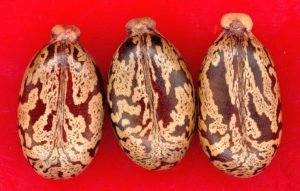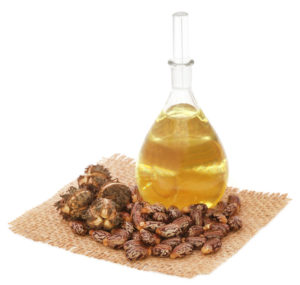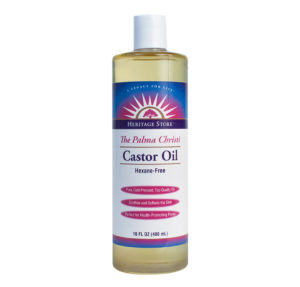Castor oil, derived from the castor seed, has been used for thousands of years to treat a wide variety of health conditions, although scientific studies are sparse.
Introduction and historical use
Castor oil comes from the castorbean seed, binomial name Ricinus communis, and has a chemical composition consisting of mostly triglycerides (40-60 % fatty acids) 90 percent of which is ricinoleic acid, believed to convene its healing properties. It is mostly cultivated in regions from India, China and Mozambique. The plant is also called Palma Christi, meaning the Palm (hand) of Christ, due to its likenesses of a human hand and its healing properties.
Castor seeds have been found in Egyptian tombs dating back to 4000 BC; the slow burning oil was used mostly to fuel lamps. Cleopatra is reputed to have used it to brighten the whites of her eyes. The Ebers Papyrus is an ancient Egyptian medical treatise believed to date from 1552 BC. Translated in 1872, it describes castor oil as a strong laxative.
Traditional Ayurvedic medicine considers castor oil the king of medicines for curing arthritic diseases. It is regularly given to children orally, for removing of parasites (worms) from their digestive tracts.
A remarkable (and gruesome!) aspect of its use in history was the usage of Castor oil as an instrument of coercion by the paramilitary Black Shirts under the regime of Italian dictator Benito Mussolini. Dissidents and regime opponents were forced to ingest the oil in large amounts, triggering severe diarrhea and dehydration, which could ultimately cause death. This punishment method was originally thought of by Gabriele D’Annunzio, the Italian poet and Fascist supporter, during the First World War.
The toxicity
Castor beans contain a potent toxin called ricin—so deadly that it’s used for chemical warfare—but don’t worry, ricin is NOT present in the commercial oil you can usually find in the stores. The toxin provides the castor oil plant with some degree of natural protection from insect pests. The poison can (and will) be extracted from castor beans by concentrating it with a fairly complicated process similar to that used for extracting cyanide from almonds.
The lethal dose in adults is considered to be 4-8 seeds, but reports of actual poisoning are relatively rare in the world.

Castor beans (Ricinus communis)
Symptoms of overdosing on ricin, which can include nausea, diarrhea, tachycardia (heart beats faster than normal), hypotension and seizures can persist for up to a week and they are troublesome.
If ricin is ingested, symptoms may be delayed by up to 36 hours but commonly begin within 2–4 hours. These include a burning sensation in mouth and throat, abdominal pain, purging and bloody diarrhea. Within several days there is severe dehydration, a drop in blood pressure and a decrease in urine output. Unless treated, death can be expected to occur within 3–5 days, however in most cases a full recovery can be made.
Once poisoned, there’s no antidote, which is why ricin has been used as a chemical warfare agent. Even though such a toxic component is also derived from this seed, castor oil isn’t considered dangerous.
The U.S. FDA gives castor oil a “thumbs up,” deeming it “generally regarded as safe and effective” for use as a stimulant laxative.
The Joint Food and Agriculture Organization (FAO)/World Health Organization (WHO) Expert Committee on Food Additives has established an acceptable daily castor oil intake of up to 0.7 mg/kg body weight. This amounts to, roughly, one tablespoon for adults and one teaspoon for children. Taking castor oil orally usually results in a “purging” of the digestive tract in about 4-6 hours.

Medicinal uses of Castor Oil
In general, the oil’s benefits can be derived by topical application; the reported medicinal uses of castor oil fall into the following five general categories:
- Gastrointestinal remedy (very strong laxative, which makes it very effective against constipation)
- Antimicrobial (antibacterial, antiviral, and antifungal)
- Labor stimulant (induces labor, so pregnant women should always consult a doctor before using it)
- Anti-inflammatory and analgesic (excellent massage oil for relieving arthritic joints, nerve inflammations, and sore muscles)
- Immune system and lymphatic stimulant
Advocates claim castor oil is most effective for strengthening your lymphatic system when it is applied topically in a “castor oil pack,” a treatment popularized by the late psychic healer Edgar Cayce in his famous “psychic readings”. A physician William McGarey MD of Phoenix, Arizona, a follower of Cayce’s work and the author of The Oil That Heals, reported that, when used properly, castor oil packs improve the function of your thymus gland and other components of your immune system. More specifically, he found in two separate studies that patients using abdominal castor oil packs had significant increases in lymphocyte production compared to placebo packs.

Castor Oil by Heritage Store (Edgar Cayce Canada)
The topical absorption of castor oil is the basis for more modern “castor oil packs” which we, the natural doctors, employ here at the Family Naturopathic Clinic for a variety of conditions. For how to make and use an Castor Oil pack, please click here.
Lymphatic congestion is a major factor leading to inflammation and disease. This is where castor oil comes in. When castor oil is absorbed through your skin (according to Cayce and McGarey), your lymphocyte count increases. Increased lymphocytes speed up the removal of toxins from your tissues, which ultimately promotes healing.
Other modern uses
Whether natural, blended, or chemically altered, castor oil still has many uses. For example:
- It remains of commercial importance as a non-freezing, antimicrobial, pressure-resistant lubricant for special purposes, either of latex or metals, or as a lubricating component of fuels.
- Castor products are sources of various chemical feedstocks.
- In Brazil, castor oil (locally known as mamona oil) is a raw material for some varieties of biodiesel.
- Castor oil has long been used on the skin to prevent dryness. Either purified or processed, it still is a component of many cosmetics today.
- Castor oil is the major raw material for Polyglycerol polyricinoleate, a modifier that improves the flow characteristics of cocoa butter in the manufacture of chocolate bars and thereby the costs.
- Castor oil is used in the USA to repel moles and voles for lawn care

One Comment
Pamela WILLIAMS
This Article Was a Good Read…Loads of Helpful & Vitally Gr8 Information….It Reinforce Some of What I Initially Thought & it Shed Light on Some Powerful Tips….Thanks Immensely!!!!